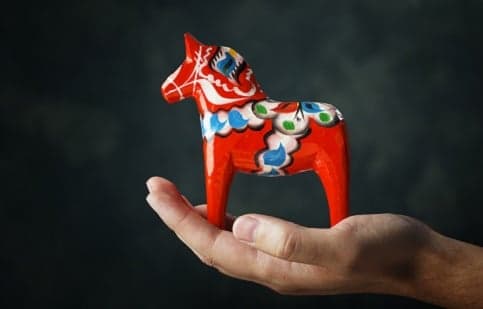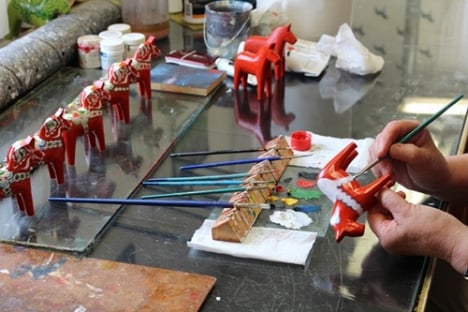The story of a Swedish symbol

Red-painted wooden horses have become a global symbol of Sweden. But have you ever stopped to wonder why? The Local spoke with the company responsible for the Dala horse's fame.
If you do a Google search for "symbol of Sweden", you'll see a bunch of gold crowns on a blue background, a few flags, maybe some peace signs... and plenty of red wooden horses.
The Dala horse (Dalahäst) is undeniably an international symbol for the country – but it hasn't always been that way.
“The Dala horse first became famous at the World Fair in New York in 1939,” Lennart Ihren, Head of production at Nils Olsson Hemslöjd told The Local.
Shop Hemslöjd Dala horses on The Local Brands
The red-painted wooden horses, a traditional toy from the Dalarna region in Sweden, first made its international debut in Paris in 1936, where they received enough attention that the Swedish committee at the fair decided to take them to New York.
“All these small producers in the region got together and created some 15,000 horses and roosters, and a 2.5 metre high horse which stood at the entrance of the fair,” Ihren explained. “It was the highlight of the event and got its picture in papers all around the world.”
Today the legacy of the Dala horse continues – and it's in no small way due to the company Nils Olsson Hemslöjd.
The company was started in 1928 by two Swedish brothers, Nils and Jannes Olsson, who were 13 and 15 at the time.
The Henry Fords of Dala horse carving, the brothers created a method of speedily hand-producing the traditional carvings.
“They just made production simpler,” Ihren said.
“They used a hand-pulled wooden bandsaw. One pulled the saw and the other sawed the horses out. That's how they started more commercial production.”
Nearly 90 years later, Hemslöjd still makes the horses the same way.
“The saws are electric,” Ihren admitted, “But otherwise it's the same.”
Workers at Hemslöjd select unneeded wood left over from building, drive it through the planer, use a rubber stamp to mark the pattern, and saw the basic shape out by hand – with help from the electric saws of course.
“Leftovers are then turned into woodchips to heat up neighbouring houses. So nothing is wasted. Except for the workers on a Friday night, perhaps,” Ihren joked.
In other words, the entire operation is thoroughly and entirely Swedish.
From there the future horses are sent out as “homework” across the Dalarna region. Workers carve out the horse shape in their homes and then return them to the factory for a quality check and a basic coat of paint. Then they are handed over for decorating.

Horses being hand-painted at Nils Olsson Hemslöjd.
Hemslöjd has two to three decoration painters working full-time, and also has a handful of painters working from home. All of the painting is done by hand.
“We've always said to tourists that if they can find two identical horses, they can have them for free,” Ihren said. “And it hasn't happened yet.”
The original Dala horses, dating back to the 1700s, were painted bright orange-red - the colour available from the local copper mine in Falun. Today Dala horses are available in a range of colours, although traditional red is still the most popular.
Other traditions have become outdated, however: The Olsson boys used to run out into the forest to catch squirrels in order to use their tails for paintbrushes. Nowadays the company simply buys brushes, Ihren informed The Local with a laugh.
Even with such a small team, Nils Olsson Hemslöjd produces about 500 finished horses every day – which then travel the world.
“I have travelled all across the globe carving horses and showing the craft,” Ihren said.
“It's obviously a symbol for the whole of Sweden when you go abroad, and most Swedes think of it that way too. There's not much that is genuinely Swedish anymore... and I think we need to cling on to this horse.”
For Ihren, the Dala horse is personal as well.
“My grandfather used to sit in our home when I was a small boy, carving horses. So I have had the Dala horse around me all my life.”
And the Dala horse isn't going anywhere, Ihren said. Sales are steadily on the rise, and the carvings are becoming popular as company gifts as well.
“Many companies want a special horse with a logo or certain colour. It's a nice gift for customers abroad,” Ihren explained.
The World Cross-Country Skiing Championship in Falun, Dalarna, this winter will also feature its own horse – both specially-designed mini versions and a larger horse signed by all of the winners.
And of course, the large Dala horse will also be made by hand – the old-fashioned way.
“We are proud to make them the same way they have always been made,” Ihren said. “It feels like we are taking care of our cultural heritage.”
Comments
See Also
If you do a Google search for "symbol of Sweden", you'll see a bunch of gold crowns on a blue background, a few flags, maybe some peace signs... and plenty of red wooden horses.
The Dala horse (Dalahäst) is undeniably an international symbol for the country – but it hasn't always been that way.
“The Dala horse first became famous at the World Fair in New York in 1939,” Lennart Ihren, Head of production at Nils Olsson Hemslöjd told The Local.
Shop Hemslöjd Dala horses on The Local Brands
The red-painted wooden horses, a traditional toy from the Dalarna region in Sweden, first made its international debut in Paris in 1936, where they received enough attention that the Swedish committee at the fair decided to take them to New York.
“All these small producers in the region got together and created some 15,000 horses and roosters, and a 2.5 metre high horse which stood at the entrance of the fair,” Ihren explained. “It was the highlight of the event and got its picture in papers all around the world.”
Today the legacy of the Dala horse continues – and it's in no small way due to the company Nils Olsson Hemslöjd.
The company was started in 1928 by two Swedish brothers, Nils and Jannes Olsson, who were 13 and 15 at the time.
The Henry Fords of Dala horse carving, the brothers created a method of speedily hand-producing the traditional carvings.
“They just made production simpler,” Ihren said.
“They used a hand-pulled wooden bandsaw. One pulled the saw and the other sawed the horses out. That's how they started more commercial production.”
Nearly 90 years later, Hemslöjd still makes the horses the same way.
“The saws are electric,” Ihren admitted, “But otherwise it's the same.”
Workers at Hemslöjd select unneeded wood left over from building, drive it through the planer, use a rubber stamp to mark the pattern, and saw the basic shape out by hand – with help from the electric saws of course.
“Leftovers are then turned into woodchips to heat up neighbouring houses. So nothing is wasted. Except for the workers on a Friday night, perhaps,” Ihren joked.
In other words, the entire operation is thoroughly and entirely Swedish.
From there the future horses are sent out as “homework” across the Dalarna region. Workers carve out the horse shape in their homes and then return them to the factory for a quality check and a basic coat of paint. Then they are handed over for decorating.

Horses being hand-painted at Nils Olsson Hemslöjd.
Hemslöjd has two to three decoration painters working full-time, and also has a handful of painters working from home. All of the painting is done by hand.
“We've always said to tourists that if they can find two identical horses, they can have them for free,” Ihren said. “And it hasn't happened yet.”
The original Dala horses, dating back to the 1700s, were painted bright orange-red - the colour available from the local copper mine in Falun. Today Dala horses are available in a range of colours, although traditional red is still the most popular.
Other traditions have become outdated, however: The Olsson boys used to run out into the forest to catch squirrels in order to use their tails for paintbrushes. Nowadays the company simply buys brushes, Ihren informed The Local with a laugh.
Even with such a small team, Nils Olsson Hemslöjd produces about 500 finished horses every day – which then travel the world.
“I have travelled all across the globe carving horses and showing the craft,” Ihren said.
“It's obviously a symbol for the whole of Sweden when you go abroad, and most Swedes think of it that way too. There's not much that is genuinely Swedish anymore... and I think we need to cling on to this horse.”
For Ihren, the Dala horse is personal as well.
“My grandfather used to sit in our home when I was a small boy, carving horses. So I have had the Dala horse around me all my life.”
And the Dala horse isn't going anywhere, Ihren said. Sales are steadily on the rise, and the carvings are becoming popular as company gifts as well.
“Many companies want a special horse with a logo or certain colour. It's a nice gift for customers abroad,” Ihren explained.
The World Cross-Country Skiing Championship in Falun, Dalarna, this winter will also feature its own horse – both specially-designed mini versions and a larger horse signed by all of the winners.
And of course, the large Dala horse will also be made by hand – the old-fashioned way.
“We are proud to make them the same way they have always been made,” Ihren said. “It feels like we are taking care of our cultural heritage.”
Join the conversation in our comments section below. Share your own views and experience and if you have a question or suggestion for our journalists then email us at [email protected].
Please keep comments civil, constructive and on topic – and make sure to read our terms of use before getting involved.
Please log in here to leave a comment.